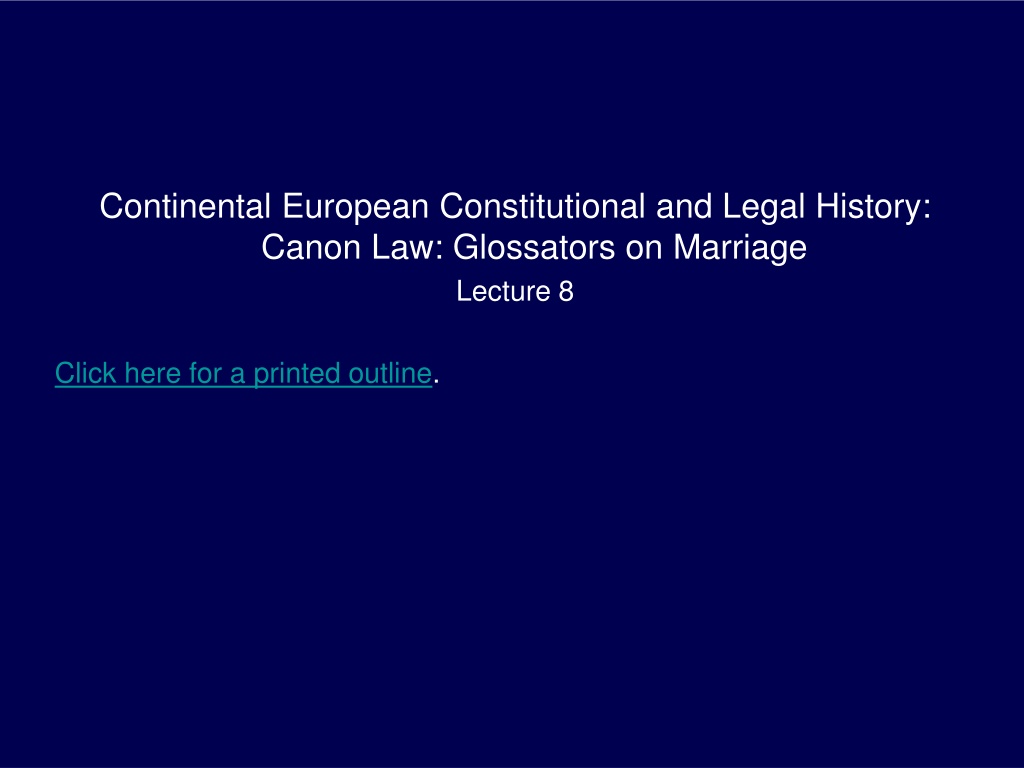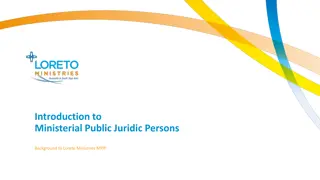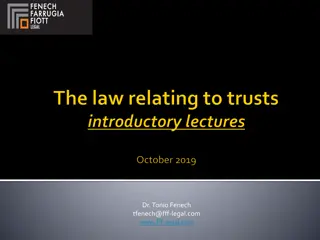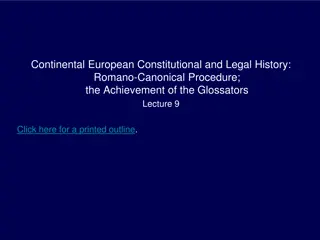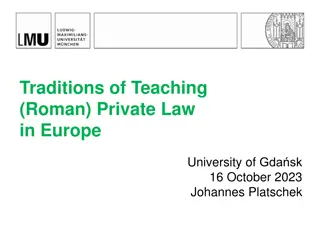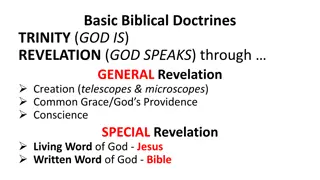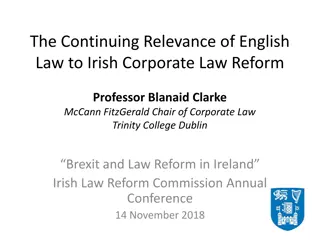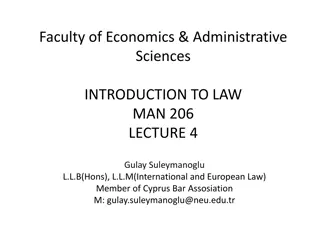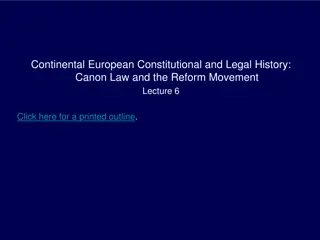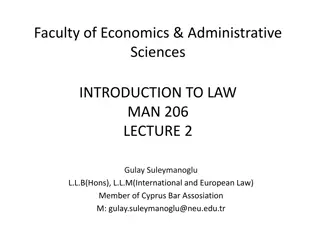Development of Canon Law: From Glossators to Gratian
This lecture explores the evolution of canon law and canonical institutions, focusing on the period leading up to Gratian's groundbreaking work. The canonic material, before Gratian's efforts to reconcile contradictions, was a compilation from various sources such as ecumenical and local councils, papal correspondence, penitentials, church fathers, and scripture. Gratian's Concordance of Discordant Canons revolutionized the study of canon law and was extensively studied and glossed by scholars like Paucapalea, Rolandus, Rufinus, and Stephen of Tournai. Later commentaries, including Huguccio's seminal work, further enriched the understanding of Gratian's contributions.
Download Presentation

Please find below an Image/Link to download the presentation.
The content on the website is provided AS IS for your information and personal use only. It may not be sold, licensed, or shared on other websites without obtaining consent from the author. Download presentation by click this link. If you encounter any issues during the download, it is possible that the publisher has removed the file from their server.
E N D
Presentation Transcript
Continental European Constitutional and Legal History: Canon Law: Glossators on Marriage Lecture 8 Click here for a printed outline.
Introduction This lecture about the development of canon law and canonical institutions. The beginning of the outline lists some of the key players in the story. One element in the outline helps to explain both what we are talking about in this lecture: A great increase in appeals to the papacy begins in pontificate of Alexander III (1159-1181) and continues in the pontificate of Innocent III (1198-1216) and beyond. Much of what we are talking about this week could not have happened had folks all over Western Europe not been asking the pope to resolve their legal problems. Roman law, which we talked about in the last lecture, though an important part of the overall story, is only a part. Indeed, in some ways it is the part that is hardest part to understand, for so far as we can tell, most of the learning of the civilians had little practical import in the 12th and 13th centuries, the time in which the civilian glossators flourished. Why Roman law was important at all is an issue to which we will have to return, although we have already suggested one possible answer: the civilians learned from their texts a method that proved powerful when applied to any kind of law.
Canon law before Gratian The first body of material to which the civilians method was applied was the study of canon law. Indeed, if recent suggestions about the dating of the early developments at Bologna are correct, the canonists developed the method at the same time, or even slightly before, the civilians did so. Unlike those who studied Roman law and the Bible, the canon lawyers had no one text. They put together their own collections of material consisting of (a) canons of ecumenical and local councils, (b) correspondance of the popes, including the Psuedo-Isidorean forgeries, (c) penitentials, (d) extracts from the fathers of the church, (e) extracts from scripture. Ivo of Chartres wrote a preface to a collection canons called the Panormia. This preface suggested a method for reconciling conflicting texts. Ivo was the last of a long line of collectors. He is also the first academic in the West since the 7th century to cite the Digest, and he never went near Bologna. One of the conclusions of some recent work on the 12th century movement to revive legal studies has been to point out that not everything happened at Bologna.
Gratian as a book to be taught Once the canonic material was organized along topical lines it was painfully apparent that it was full of contradictions. Gratian of Bologna undertook the task of making sense out of it, and his masterpiece, the Concordance of Discordant Canons, aka the Decreta, but never in his time the Decretum, was published. A first edition may have been in existence as early as the early 1130s, a second seems to have appeared in the late 1140s. Gratian s book was quickly seized upon as a teaching tool, studied and glossed. The earliest commentary on the book is by Paucapalea; there follow commentaries by Rolandus, Rufinus, and Stephen of Tournai. These four men roughly correspond to the four doctors of Roman law. The greatest commentary on Gratian is by Huguccio, written in the 1190s and still mostly unedited. The ordinary gloss on Gratian was composed by Johannes Teutonicus (John the German) in the first years of the 13th century with later additions by Bartholomew of Brescia in mid-century, roughly ccontemporary with Accursius.) .
The decretals Unlike the civil lawyers, the canon lawyers had a working court system in which to try out their ideas. In the 12th century there was an extraordinary increase in appeals to Rome and in bishops asking how to decide cases that had arisen in their courts. Frequently the pope would send the appeal cases back to judges delegate in local areas accompanied by writtten instructions or would write back an answer to the bishop who asked the question. These decretal letters were collected into books, some of the most important of which are of English provenance. .
The decretals (contd) The five old compilations (compilationes antiquae), listed on the outline, were all systematic collections of decretal letters that were used for teaching canon law. In 1234, Gregory IX had an official collection made, and this book, too, rapidly came to be studied and glossed. Another important collection of decretals since Gregory IX was made by Boniface VIII in 1298, but by this time the effort was running out of steam. Three smaller collections were made in the 14th and 15th centuries, but the vast bulk of what a later age called the Corpus Iuris Canonici consists of Gratian, Gregory IX and Boniface VIII. The truly creative period of medieval canon law corresponds to the period of the glossators of Roman law, roughly 1100 1250. The types of literature that the canonists created are basically the same as the civilians with some variants in terminology. Their methodology, too, was similar to that of the civilians: glosses, distinctions, questions, summae.
Gratian, Causa 27, quaestio 2. The material that I want to focus on in this lecture is somewhat different, although the difference is more one of degree than of kind. First, an extract from Gratian s Concordance of Discordant Canons. Its organization is quite similar to that of a canonic collection, a collection of relevant material arranged under a heading that focuses on a particular issue. This one could have been a collection of material under the title May one who is espoused leave his espoused and marry another? , followed by some fifty snippets from the fathers, the decretal letters of various popes, and canons of councils. What makes Gratian s treatment different is that the argument of the teacher is woven into the material in the so-called dicta Gratiani, the sayings of Gratian. It is also different in that this part of Gratian is not arranged according to some abstract order of titles, but rather is arranged in the form of a quaestio disputata, a hypothetical set of facts that are then broken down into issues. Even the organization of material within each issue is governed by the argument that Gratian is making. In Gratian, then, we are able to see a Bolognese teacher at work at a remarkably early period. We don t have to guess, as we frequently had to with Accursius, why he citing a particular authority; he tells us why.
Gratian, Causa 27, quaestio 2 (contd) A certain man who has taken the vow of chastity espoused [desponsavit] a wife; she, renouncing the previous match, betook herself to another and married him; he seeks after her to whom he was previously espoused. [quaestio 1] The first question is whether there can be marriage between those who have taken a vow of chastity? [quaestio 2] Second, is it permitted for one who is espoused to leave the one to whom she is espoused and marry another? The answer to the first question ends with a distinction: a solemn vow of chastity, such as that taken in religious profession, bars subsequent marriage, but a simple vow does not.
Gratian, Causa 27, quaestio 2 (contd) The second question follows in which we seek to discover whether a girl espoused to another man can renounce the previous match and transfer her vows to another. First, we shall see whether they are married, second whether they can depart from each other. We have already seen that the Christian tradition was firmly committed to the indissolubility of marriage, but logically, and indeed in the Roman secular world, the two questions were not the same, and Gratian s analytic technique here provides the first clue as to how he is going to come out. Gratian s answer is going to be that the couple are married when they were espoused but the marriage was not indissoluble until they had sexual intercourse.
Gratian, Causa 27, quaestio 2 (contd) Roman law made a sharp distinction between engagements, which they called espousals, promises of marriage, and nuptials, the marriage itself. Nuptials were characterized by the exchange of consent between the bride and groom and the exchange of consent of their fathers if either or both of them were in their power, and, almost everyone who had a living father was in power. Whether anything more was required is controversial, but there are a number of texts in the Digest that seem to require some form of ceremony, or at least some form outward manifestation of the consent, which in Roman wedding ceremonies took place when the bride was led to the house of the groom, the so-called deductio in domum mariti, the leading of the bride into the house of the groom. Intercourse was not required. An unconsummated marriage was still a marriage. Any marriage was, of course, dissoluble. Roman law freely allowed divorce.
Gratian, Causa 27, quaestio 2 (contd) The Germanic law of marriage, to the extent that it may be said to exist, is even less well known than the Roman, but it seems to have a number of characteristics that differentiated it from the Roman. Unlike Roman law, Germanic law seems to have placed more emphasis on the initial exchange of consent, engagements were more like marriages and less like the Roman espousal, and more emphasis on intercourse; until the parties had had intercourse, they were not fully married. Indeed, some customs suggest that they were not fully married until the birth of a living child. Gratian s resolution is to separate the definition of marriage from the characteristic of indisollubility. Marriages are made by consent but they are not indissoluble until the parties have intercourse. We have already suggested that this resolution is consistent with the Christian tradition, because the sayings in the New Testament on the indissolubility of marriage seem to make it depend on husband and wife having become one flesh, and the sacramental character of marriage, the relationship between Christ and the Church that we see in the letter to the Ephesians seems to depend on the same thing.
Gratian, Causa 27, quaestio 2 (contd) Gratian s resolution, however, cannot be made exclusively on scriptural grounds. Gratian is writing in the 12th century not the 2d, and there s a lot more there he has to reconcile in order to get where he wants to go. There are a large number of quotations, mostly from ancient authors writing in a Roman milieu, that say, or imply, that intercourse does not make a marriage. Typical among these is the quotation from an anonymous author thought to be great Greek father John Chrysostom quoted as canon 1: Coitus does not make a marriage, but will does. Or the statement of the ninth century pope Nicholas I, that we ve already examined, quoted as canon 2: According to the laws, consent alone between the parties suffices when the question is whether parties are married. If that alone is lacking, anything else, even if accompanied by coitus, is frustrated. Indeed, the first fifteen canons that Gratian quotes all seem in different ways to come down against the argument that Gratian wants to make.
Gratian, Causa 27, quaestio 2 (contd) Gratian s answers to these texts, which seem to constitute a powerful objection to his thesis, does not come until the dictum post canon 45 (Mats., p. VIII 10), too long to be quoted here. The answers seem to boil to two arguments: (1) in context these quotations do not support the view that marriages without intercourse are indissoluble, and (2) there s a distinction between necessary and sufficient conditions. Gratian does not offer these arguments at this point. Rather, having gathered together 15 canons that do not seem to support his position, Gratian then offers two that to his mind do: Canon 16: [Attributed to Augustine]: There is no doubt that a woman who has not had intercourse is not a married woman. Canon 17: Again Pope Leo [to Rusticus of Nabonne, Ep. 167, 458 9].: Since the partnership of nuptials was so instituted from the beginning that it does not have in itself the sacrament of the nuptials of Christ and the Church unless there has been a mingling of the sexes, there is no doubt that that woman does not pertain to marriage in whom it is learned that there was not nuptial mystery.
Gratian, Causa 27, quaestio 2 (contd) The core, however, of Gratian s argument does not rest on these questionable texts. It rests rather on what he deems to be church practice in five different specific areas: Canons 18 27: The ancient discipline of the church, as we have seen in 74T, is quite clear that married couples could not espouse the religious life without mutual consent. There were, however, a few authorities that seemed to make an exception. Although none of these authorities specifically say that the exception is where the couple have not had intercourse; they are open to that interpretation, and this is the way that Gratian interprets them. Canons 28 34: These deal, somewhat confusedly with the following problems: (1) impotence, (2) the prohibition against a clergyman to marry a widow, (3) penalties for incest, and (4) raptus. The ancient discipline of the church on frigidity or impotence was also not completely clear. (d.p. c.28) Some authorities held that in sickness and in health meant just that; others seemed to make an exception for this kind of sickness. Like the question of the entry into the religious life, while none of them mention the pre-intercourse, post-intercourse distinction, they can made to be consistent if one employs that distinction.
Gratian, Causa 27, quaestio 2 (contd) I will leave it to you to work out the examples of so-called bigamous clerks, the prohibition on clergymen to marry twice or to marry a widow, and the ancient penalties for incest. Suffice it to say here that the authority on which the resolution about bigamous clerks rests is suspect, but if it is genuine, it definitely supports Gratian s distinction. In the case of the murky area of incest, there is little doubt that the Germanic local councils quoted here regarded incest with an affine of one s wife or husband as more serious if the marriage had been consummated than if it did not. On the problem of raptus (which frequently means abduction rather than rape in the modern sense) as illustrated by canon 34, Gratian may have misread the text, but he is right in seeing that in this Germanic context, the fact that the espoused woman has not had intercourse with her espoused does make a difference. Otherwise, we would be dealing simply with a case of rape of a married woman or adultery, and it is clear that the council does not see it as either.
Gratian, Causa 27, quaestio 2 (contd) Gratian s most difficult case is unique, the marriage of the Blessed Virgin Mary. By the 12th century it had become clear that as a dogmatic matter both that Mary and Joseph were true husband and wife and that they never had intercourse. Gratian reconciles this with his position by saying that it is perfectly true that were married, just that it wasn t an indissoluble marriage. After this the rest of the authorities are a piece of cake. Of course, one ought to marry one s espoused, and if one hasn t and especially if the espousal has been a solemn, church authority can forbid another marriage. But that s not the issue. If such a marriage takes place, what then? Unless the espousals have been consummated, Gratian says, the subsequent marriage is to prevail. To be consistent, he should have added that the subsequent marriage must itself be consummated before the first one.
Peter Lombard of Paris on the Formation of Marriage Dealing with many of the same texts as Gratian, the Lombard came to a different conclusion: indissoluble marriages are formed by exchange of words of present consent. Sexual intercourse has nothing to do with it. Promises to marry, however, are dissoluble. The Lombard s ideas are derived from Hugh of St. Victor (about a generation earlier) who espoused the idea of a dual scarmentality of marriage. The canonic Summa Pariensis (1150s) and the canonic Summa Coloniensis (1160s) argue that this conflict between the Parisian view on this topic and the Bolognese view is not good for the unity of the Church.
Alexander III on the Formation of Marriage It would seem that Alexander III went through at least three, and perhaps four, stages, in arriving at his ultimate resolution. The first stage is illustrated by Veniens . . . B (Mats., p. VIII 16), decided sometime in the 1160s. In it Alexander seems to be holding that any espousal, whether or not accompanied by intercourse, is binding and prevails over a second espousal. If this is the holding of this case, it conforms neither to Gratian s nor to Lombard s theory, and may represent the ancient discipline of the Roman church (compare Nicholas I to the Bulgarians). The second stage is illustrated by Sicut Romana (p. VIII 16), written to a French archbishop in 1173 or 1174. This decretal does not say that the unconsummated marriage that was to prevail over a second marriage was one of the present tense, nor is it completely consistent with the Lombard s thinking because it makes the issue of entry into religion dependent on whether the woman has had intercourse.It seems, however, to reflect the influence of Lombard s thinking with its focus on the type of consent. There is one other decretal (Sollicitudini, VIII 19), which probably belongs to this period, that shows the same.
Alexander III on the Formation of Marriage The thrid stage might be called the solemnity period . If Alexander was heading in the direction of the Lombard s thinking in the early 1170s he changed his course very briefly in the mid 1170s. Both Ex litteris (p. VIII 16) and Licet preter solitum (p. VIII 17) hold that an unconsummated present consent marriage will prevail over a subsequent one accompanied by intercourse, but both require (Ex litteris so holds in the strict sense) that the present consent be accompanied by the solemnities customary in the area. At the end of his pontificate Alexander abandoned the solemnity requirement (something that he held only briefly, see Quod nobis, p. VIII 19). Two decretals from after 1176 (one certainly so, one probably so), Significasti, p. VIII 18, and Veniens ad nos, p. VIII 19), come up with the following rule scheme: Present consent freely given between a man and a woman capable of marriage makes an indissoluble marriage, unless prior to their having sexual intercourse one of the parties choses the religious life.
Alexander III on the Formation of Marriage Future consent freely given between a man and a woman capable of marriage makes an indissoluble marriage, if that consent is followed by intercourse. With few exceptions any Christian man is capable of marrying any Christian woman, so long as they are of marriageable age, not in higher orders or solemn vows, and not too closely related to each other. The extraordinary thing about these rules, which prevailed throughout the West until the council of Trent in 1563, is not what they require but what they don t require. No solemnity or ceremony of any sort was necessary to make an indissoluble marriage; no parental consent was required; there were no class barriers to marriage. We will have occasion to ask later how these rules were received by a society in which arranged marriages were the norm, cross-class marriages were uncommon, and ceremonies accompanied every important aspect of life.
Why Did Alexander III Decide as He Did? Christian marriages once fully formed were indissoluble. Alexander was committed, as was the church of his time, to incorporating as many people as possible within the realm of orthodox Christianity. Twelfth century thought, both religious and secular, puts a heavy emphasis on individual choice. Within this context, a consensual system of marriage has obvious attractions. As these principles emerge as the principles all else tends to fall by the wayside.
How Does Accursius React to Alexanders Decisions? (Mats., pp. VIII 21 to VIII 22) As a practical matter, marriage was not a topic that belonged to the civilians in the 13th century. The civilians seem to have reinterpreted their texts to keep things in line with the canonists. But they did not drop the parental consent requirement for children who are in the power of their fathers. Justinian had said that those in power must have the consent of the parents in whose power they respectively are, the necessity of which, and even of its being given before the marriage takes place, is recognized no less by natural reason than by law. Accursus glosses this passage (Gloss 8) to say otherwise, it [the marriage] is not valid.
Accursius Reaction to Alexanders Decisions (contd) The only suggestion that Accurssius is aware of the problem does not come until later where he is glossing the passage that describes Justinian s ruling that the child of father who is insane may marry if the child obtains the consent of the father s curator (Gloss 17): But by the law of the canons the consent of those whose matrimony is at stake suffices; but this perhaps is understood for others, not for children in power, or I believe that this is corrected because it is also an honest thing like going into a monastery. Here what he says at the end suggests that he may countenance the proposition that the canons have corrected the civil law. This passage probably does not mean that the whole law that he has just explained has been corrected. It may mean that just the law about lunatics has been corrected. What he may, also, be suggesting is that the consent cannot be unreasonably withheld.
Accursius Reaction to Alexanders Decisions (contd) Having won the war, Accursius prepared to concede the battle (Gloss 8). The father is deemed to consent unless he expressly forbids the marriage. The fact that the civilians were willing to bend their texts to make them fit the canonic requirements shows us that another drive toward unity was operating in the system. If the canonists complaints about the lack of unity in the customs of the churches on the basics about marriage reflect the strong drive toward unity that they felt as religious matter, the fact that the civilians were willing to bend their texts to make them fit the canon law shows that legal unity as well as religious unity were thought to be important. It is then all the more interesting that in this one important area, parental consent, the civilians, by and large, refused to budge Their holding on this issue remained largely in the realm of the academic. It did, however, remain as a kind of time bomb ready to go off whenever anyone was ready to challenge the exclusive jurisdiction of the church over the question of the formation of marriage. As we will see, that will happen in the 16th century.
